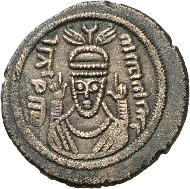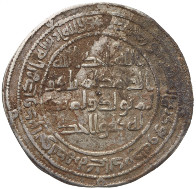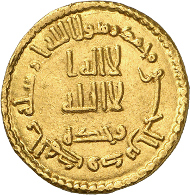A Coined History of the Islamic World
Although it was no more than 92 lots they nevertheless illustrated 13 centuries of Islamic history, from humble beginnings in the late 7th century until the great empires of the past.
Anonymous. Copper pashiz, undated, around 72-95 AH (= 691-715), Istakhr. Numismatica Genevensis 8 (2014), 219. Estimate: 3,000 CHF. Hammer price: 20,000 CHF.
Coins are the earliest evidence of an Islamic identity that has come down to us. Yet we have to know how to interpret the coins in order to grasp their historical message. A case in point is this copper pashiz that has been minted at some point between 691 and 715. It depicts a Sassanid ruler with both index fingers raised, pointing upwards. This gesture was understood by contemporaries. It represented the submission to Allah and was part of the confession of faith of a proselyte.
This coin takes us back to the time of the first Arabic expansion: in 636, the warriors of Umar sent Sa’ad ibn Abu Waqqa conquered the Sassanid Empire in the aftermath of the Battle of al-Qadisiyyah. They became the new rulers of a rich country where the merchants of Mesopotamia engaged in business with the entire then known world. Via the Silk Road, Sassanid coins made their way to China and the icy northern parts of Scandinavia.
Yad’ab Dhubyan Yuhargib, around 155-135 B. C. Tetradrachm, undated. Numismatica Genevensis 8 (2014), 274. Estimate: 50,000 CHF. Hammer price: 135,000 CHF.
That the Arab peoples had an age-old tradition of minting coins and knew how to use this medium is evidenced by a unique tetradrachm that was made around the middle of the 2nd century B. C. It shows two male portraits we have not yet identified for sure.
What is clear, however, is the fact that the new, Arab rulers of the Sassanid Empire knew how important coinage was for a working economy. Thus, they continued minting those coins their new subjects were used to. Yet they added little, though clearly visible, hints at Ahura Mazda being replaced by Allah as supreme deity of the empire.
Bishr bin Marwan, AH 73-75 (692-694), drachm AH 75 (694), Basra. Numismatica Genevensis 8 (2014), 221. Estimate: 20,000 CHF. Hammer price: 62,000 CHF.
The zoroastrian fire altar of the traditional coins of the Sassanid rulers was eliminated by the new rulers and substituted by a clear religious statement: at the spot where the fire altar used to have been, a drachm of Bishr bin Marwan depicts the caliph in adoration, raising his hands to the sky. On both sides – just like the guards in front of the fire altar earlier – there are two persons bearing witness to his prayer.
Bishr bin Marwan was the brother of the great Caliph ’Abd al-Malik bin Marwan who planned to carry out a major monetary reform in his huge empire…
Byzantine solidus of Heraclius with his sons Heraclius Constantine and Heraclonas, 632-641. Numismatica Genevensis 8 (2014), 226.
Back then, ’Abd al-Malik ruled Mesopotamia, Syria, Palestine and Egypt. Many of these territories used to have been controlled by the Byzantines. Byzantine gold coins were circulating everywhere. Featuring crosses on both sides these solidi propagated a message the Umayyad caliphs intended to oppose.
Umayyad coinage. Undated Arab-Byzantine solidus, around 60-72 AH (= 679-691). Numismatica Genevensis 8 (2014), 226. Estimate: 75,000 CHF. Hammer price: 200,000 CHF.
It was the founder of the Umayyad Dynasty, the first Caliph Mu’awiya, who, in the aftermath of the conquest of Syria, needed a surrogate for the Byzantine gold coins that circulated in that area. The first Islamic gold coinage was the result. These coins imitated the Byzantine models, albeit with a major difference: the Christian symbols, the crosses on both crown and reverse, became religiously inconspicuous pillars.
‚Abd al-Malik bin Marwan, 68-86 AH (= 685-705). Dirham, 81 AH (= 700), Dasht Maysan. Numismatica Genevensis 8 (2014), 230. Estimate: 8,000 CHF. Hammer price: 9,500 CHF.
’Abd al-Malik went even further. He had all Persian and Byzantine coins that were used in his empire replaced by his own coinage. In the year 74 AH (= 695), he issued gold coins with a completely new imagery, that went down in monetary history as the ‘standing caliph’. He soon realized, though, that this was not a good choice. It appeared far too similar to the Byzantine model with the standing ruler. The new religion needed a completely new und unparalleled motif. Consequently, dinars and dirhams were produced that exhibited nothing else but an inscription with which the ruler expressed his Islamic faith.
‚Abd al-Malik bin Marwan or his successor. Dirham 86 AH (= 705), Tiflis. Numismatica Genevensis 8 (2014), 232. Estimate: 40,000 CHF. Hammer price: 55,000 CHF.
The silver dirhams soon came into use everywhere merchants dealt with precious goods. Also they were produced in those areas where soldiers of the Umayyad army received their pay. This rare specimen was struck in Tiflis / Georgia.
Sulayman, 96-99 AH (= 715-717). Dirham, 97 AH (= 715-716), al-Hind. Numismatica Genevensis 8 (2014), 238. Estimate: 150,000 CHF. Hammer price: 540,000 CHF.
Umayyad dirhams were produced as far away as India. This extremely rare item harks back to an expedition conducted by the important general Muhammad bin al-Qasim. He conquered the Indus Valley and successfully installed a firm control over the territory. When the caliph died in Damascus, though, Muhammad bin al-Quasim as his favorite was stripped of his office by the caliph’s successor and executed. New generals controlled the territory. Under their rule, this unique coin was made whose place of minting is given, al-Hind. This means that the coin was struck in the area east of the Indus, perhaps in the important city of Multan, located in modern Pakistan.
Hisham, 150-125 AH (= 724-743). Dinar, 110 AH (= 728/9), al-Andalus. Numimatica Genevensis 8 (2014), 246. Estimate: 30,000 CHF. Hammer price: 80,000 CHF.
Likewise the coins produced in Andalusia were not marked by the Cordoba Mint but were added the lettering al-Andalus.
al-Muqtadir, 295-320 AH (= 908-932). Heavy dinar, 303 AH (= 915-916), Madinat al-Salam (= Baghdad). Numismatica Genevensis 8 (2014), 257. Estimate: 15,000 CHF. Hammer price: 42,000 CHF.
The founder of the Abbasid Dynasty descended from Mohammed’s youngest uncle, Abbas ibn Abd al Muttalib. The Abbasids therefore demanded that a caliph had to be blood-related to Mohammed, a condition the Umayyads did not fulfill. The power of the Umayyads dwindled constantly, and in 145 AH (= 762), the Abbasids moved the caliph’s residence to Baghdad. Gorgeous Baghdad stands for Islam’s golden age, for universities, public hospitals and scientific progress. Baghdad became an international commercial hub frequented by ambassadors from all around the world. Even Charlemagne sent diplomats and gifts which Harun ar-Raschid reciprocated with the famous elephant called Abul Abbas. Less important rulers were honored with coins as presents, just like this heavy dinar from 303. With its broad planchet, the fine striking and the heavy weight of 5.14 g it was a worthy gift for a visitor of high rank.
al-Mutawakkil, 232-247 AH (= 847-861). Dinar, 234 AH (= 848-849), Mecca. Numismatica Genevensis 8 (2014), 276. Estimate: 30,000 CHF. Hammer price: 32,000 CHF.
Only a few coins of the Abbasids were minted in Mecca. They, too, are very likely to have served ceremonial purposes.
Umar bin Muhammad, 357-358 AH (= 967-968). Dinar, 357 AH (= 968), Oman. Numismatica Genevensis 8 (2014), 280. Estimate: 125,000 CHF. Hammer price: 130,000 CHF.
It was almost impossible for the Abbasids to control all the rising local leaders on the fringes of the empire. One of these was Ali bin Ahmad in Oman. He hedged his bets, referred to rulers of the Buyid Dynasty in Iran on his coins as well as the representatives of the council of elders of the Qarmatians of Bahrain and the Abbasid caliphs. The loyalties and hence the names stated on the coins changed according to the political situation. This specimen, for instance, skips the Abbasid caliph.
The fact that many minting authorities name those rulers they acknowledged in their legends renders coins a very important tool for the reconstruction of the history of those regions and periods of which only few written sources have survived.
Timur (Tamerlan), 771-807 AH (= 1370-1405). Dinar, 786 AH (= 1384), Isfahan. Numismatica Genevensis 8 (2014), 291. Estimate: 20,000 CHF. Hammer price: 42,000 CHF.
Timur, the Emir of Transoxania, came of humble stock, to become the ruler of most of Central Asia. His coins take account of his origins in that they only rarely state his name. Instead, he issued coins in the name of the ruler of the Chagatai Khanate who was entirely deprived of his power back then. Timur’s name appears on only a handful of coins. This unique specimen is the largest denomination carrying his name.
Nur-Ud-Din Muhammad Jahangir, 1014-1037 AH (= 1605-1628). Mohur 1020 AH (= 1611). Numismatica Genevensis 8 (2014), 307. Estimate: 100,000 CHF. Hammer price: 200,000 CHF.
Jahangir, son of the great Mughal ruler Akbar, was the first to issue coins bearing a portrait again, after centuries of coins that had lacked any figural representation. The impressive specimen depicts the ruler to the left, wearing an elaborate garment, his turban set in an aureole, matching his portrait on extant paintings.
This emission was produced solely for representational purposes. As the great number of written sources on the Mughal Empire reveal, this coin was given exclusively to Jahangir’s favorites who attached it as an agraffe to their turban or their garment, in the same way as a protective amulet was worn.
The Islamic coinage offers a wealth of historically highly interesting coins that are an indispensable primary source on Muslim history.
The whole catalogue of the Numismatica Genevensis auction you may find here as a pdf.




































